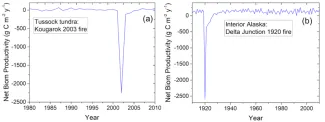Fire is an important driver of the carbon cycle across northern ecosystems. The impact of recent and predicted changes in fire regimes on net carbon exchange is uncertain. Here we applied an ecosystem model, ecosys, to examine the effects of fire on surface energy and land-atmosphere carbon exchanges across selected sites in Alaska. The model was prescribed with known fire vs. non-fire (control) events across the selected sites. Changes in surface energy budget during fire chronosequence were modeled to drive differences in soil temperature across sites. Soil temperature was warmer in the post-fire vs. the control during summer and spring but colder during winter. An average of ~30 % reduction in ecosystem net radiation (Rn) was modeled in the postfire vs. the control sites. Greater differences in Rn and sensible heat during spring vs. fall were modeled from differences in surface albedo. Modeled heterotrophic respiration (Rh) was higher in the postfire sites in spring from earlier soil warming. However, lower Rh was modeled during fall and winter from soil cooling as a result of lesser insulation of the soil surface layer after fire. Emissions from fire was modeled to result in carbon losses that offset from 20 to >100% of the decadal carbon sinks across the selected sites.
For more information, please contact:
Zelalem Mekonnen
zmekonnen@lbl.gov

